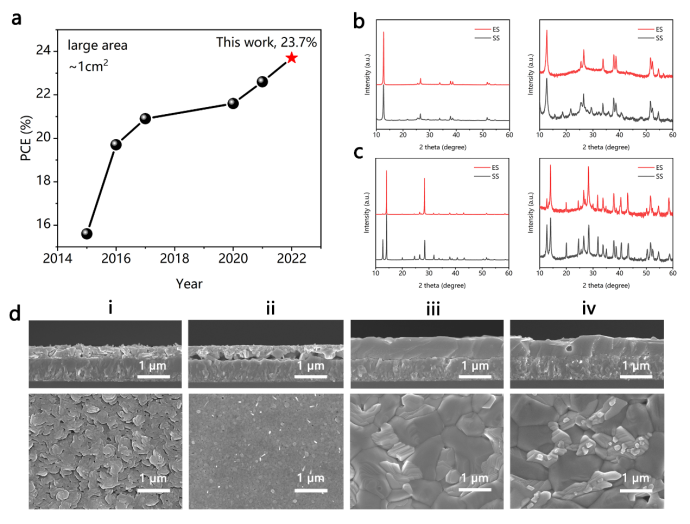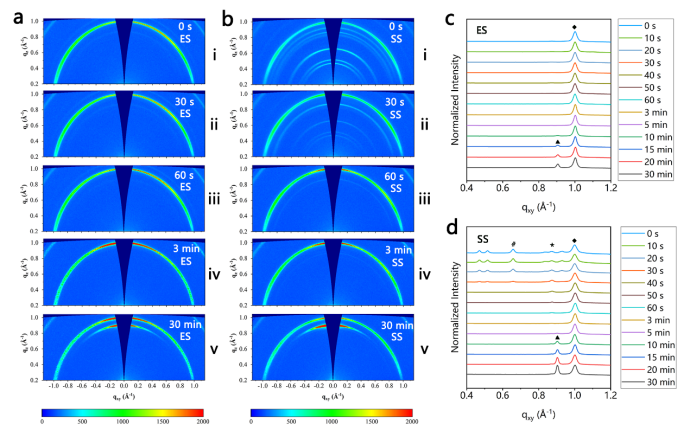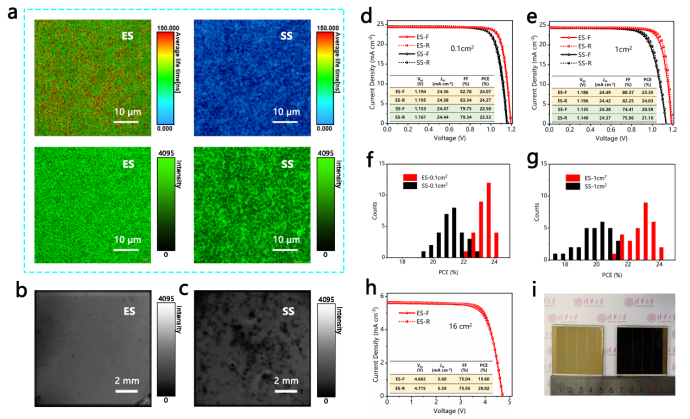Recently, Yi Chenyi’s research team from the Department of Electrical Engineering and Applied Electronics (EEA), Tsinghua University, realized the preparation of a highly repeatable and high-efficiency perovskite solar cell (PSC) by combining vacuum evaporation of lead salt and organic ammonium salt solution treatment (ES for short), and achieved the world highest photoelectric conversion efficiency record of 24% at a large area (1cm2). The achievement was published in the international academic journal “Advanced Materials”.
PSC, superior in high photoelectric performance, low cost and simple processing, is a photovoltaic technology with broad application prospects. At present, most high-efficiency perovskite solar cells are prepared by the solution spinning (SS for short). However, the complex solution chemistry of perovskites precursors renders it difficult to prepare large-area devices in a reproducible way, which is a prerequisite for the technology to make an impact beyond lab scale.
Vacuum processing, instead, is an established technology for large-scale coating of thin films. With respect to the hybrid perovskites it is highly challenging due to the high vapor pressure of the organic ammonium halide.

Progress of certified records of 1cm2 large-area perovskite solar cell efficiency, characterization of thin film vacuum evaporation & solution (ES) VS thin film & full solution (SS)
In this research, integrating the advantages of the vacuum evaporation method with those of the solution method, a large-area uniform lead iodide template is made through vacuum evaporation deposition, and ammonium halide solution is taken into reaction with lead iodide to realize highly reproducible preparation of large-area uniform perovskite film. On the one hand, compared with the preparation of lead iodide substrate by the solution method, the preparation of lead iodide by vacuum evaporation avoids the environmental impact on the deposition, and high-quality large-area lead iodide templates can be produced repeatedly. On the other hand, ammonium salt deposition by the solution method avoids the uncontrollability caused by the high vapor pressure of ammonium salt in the vacuum evaporation method. Therefore, this perovskite preparation process has favorable controllability and repeatability. Further thin film characterization and in-situ tests proved that, compared with the solution method, the vacuum evaporation & solution method showed a better crystallization reaction mechanism, and the lead iodide and perovskite films prepared by this method has better morphology structure and crystalline quality. Especially on a large-area scale, the method of vacuum evaporation & solution combination can greatly reduce the pores and defects of perovskite films, which supports the preparation of large-area devices.
The perovskite solar cells prepared by this method exhibit excellent optoelectronic performance and good expandability, with a power conversion efficiency of 24.3% (certified efficiency 23.9%) on a small area (0.10 cm2), and a power conversion efficiency of 24.0% (certified efficiency 23.7%) on a large area (1 cm2), which is a new efficiency record on large-area (1 cm2) perovskite cells. On this basis, the authors also prepared a small perovskite module, with an efficiency of 20.0% for minimodule (16 cm2), and maintain 90% of its initial efficiency after 1000h 1-sun operation.

In-situ GIWAXS test to characterize the reaction mechanism of perovskite thin films prepared by different methods

Characterization of optoelectronic properties of perovskite thin films and devices prepared by different methods
This method can be used to prepare large-area high-efficiency perovskite solar cells with exceptional reproducibility, which provides a promising way for the large-scale application of perovskite solar cells. The achievement was published in the international journal Advanced Materials with the title of “Combined vacuum evaporation and solution process for high efficiency large-area perovskite solar cells with exceptional reproducibility”. The corresponding author of the paper is Yi Chenyi, and the co-first authors are doctoral students Tan Liguo, Zhou Junjie, and postdoctoral Zhao Xing from EEA. The collaborators include researcher Ding Liming from the National Center for Nanoscience and Technology, Dr. Wolfgang Tress from Zurich University of Applied Sciences, Switzerland, and Professor Michael Graetzel from the Swiss Federal Institute of Technology in Lausanne University. The work was funded by the National Natural Science Foundation of China, the independent scientific research project of Tsinghua University, and the independent scientific research project of the State Key Laboratory of Power Systems, and supported by Focus e-Beam Technology, Beijing Synchrotron Radiation 1W1A Diffuse Scattering Ray Station, Shenzhen Leaderwe Intelligent Co., Ltd.
Paper link: https://onlinelibrary.wiley.com/doi/abs/10.1002/adma.202205027

















 News & Events
News & Events